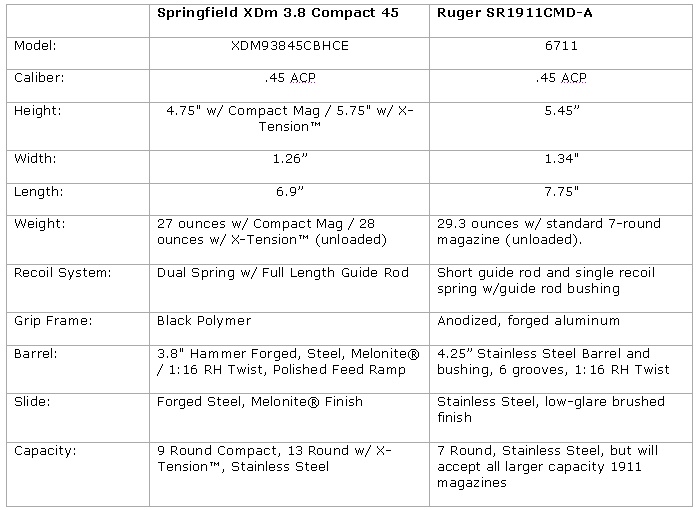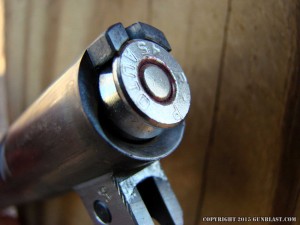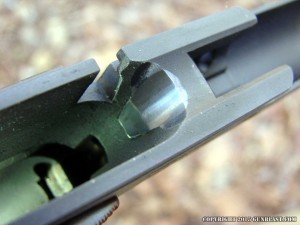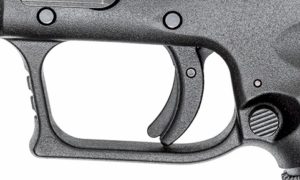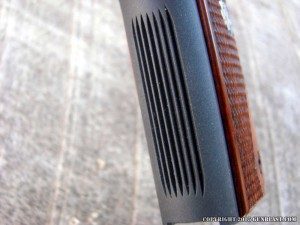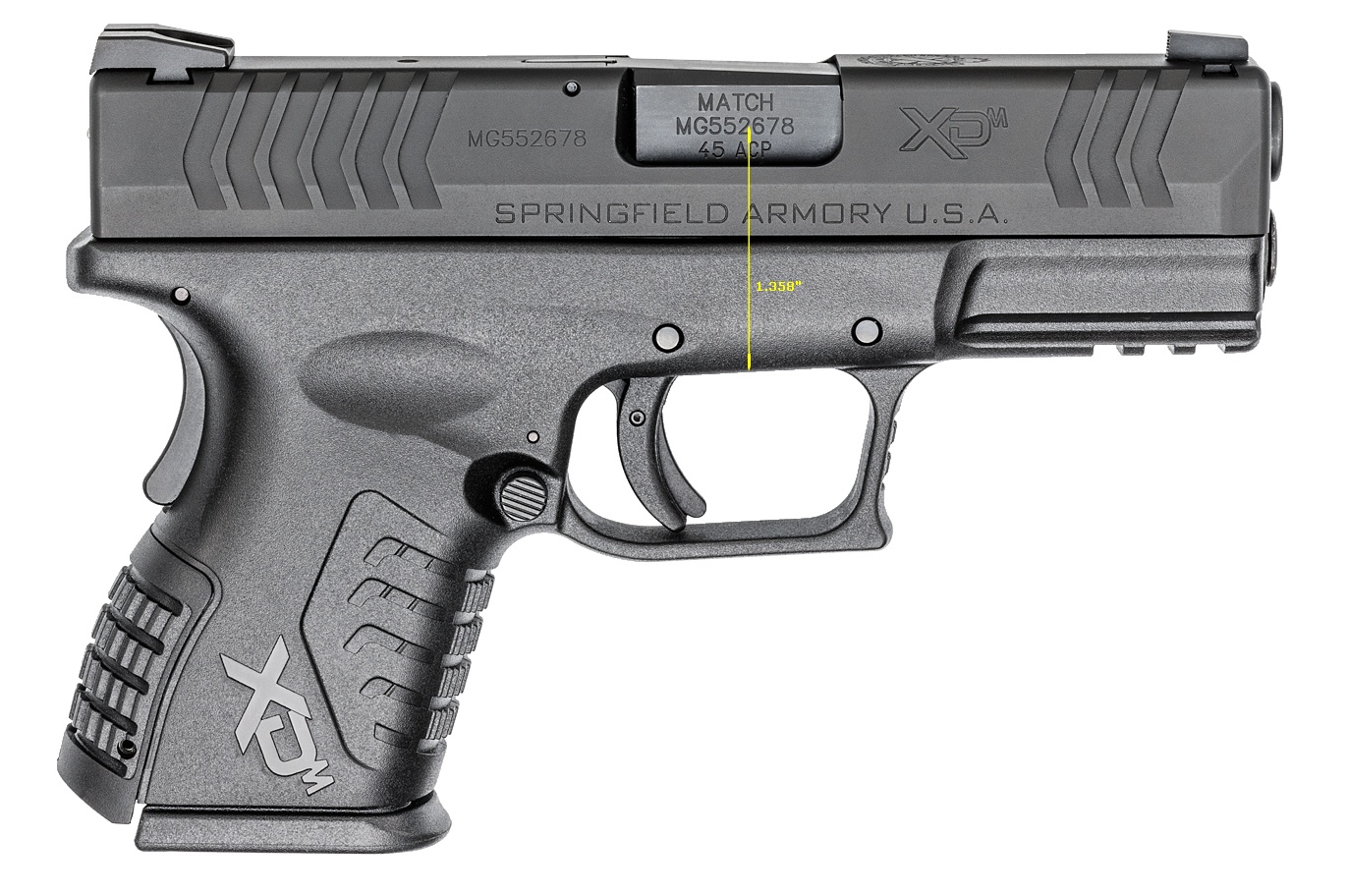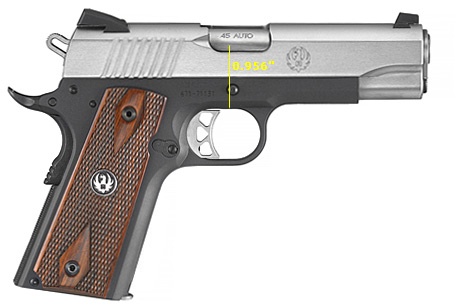 Let’s talk about apples and oranges.
Let’s talk about apples and oranges.
Sometimes when we decide to carry a certain firearm for EDC the choice is simple. We may be a “brandaholic” and choose a pistol by brand regardless of the plusses and minuses of the firearm itself. In my case, it is not only a brand, but a platform.
I have carried all manner of firearm for EDC, large, small, long, and short and I admit to having developed a preference over the years for the 1911-based pistol because it simple and has simply worked for me. When striker-fired pistols entered the marketplace, I pretty much stayed away from them, but my curiosity got the best of me and I purchased my first Glock pistol – a Glock G17 GEN3. You can tell by the generation of that pistol that I held out for quite a while. However, the G17 was never intended for carry but was more out of curiosity as to what a striker-fired pistol could offer over a hammer-fired pistol – if any. While I have acquired a few more Glock pistols, they are not my first consideration for EDC. However, there has been a few other considerations.
My latest acquisition of the Springfield Armory 3.8 Compact 45 was an attempt to determine if this pistol was destined to be my next EDC over what I currently carry, A Rock Island Armory Standard Full Size (FS) 1911. Obviously, there is a weight advantage to carrying the Springfield Armory 3.8 Compact 45, and added round difference in capacity, but there has to be a little more than that in my book. I also have a Ruger SR1911CMD-A, the lightweight version of a “Commander Model” 1911 and which has demonstrated excellent form and function. Although I have written individual reviews on each of these pistols (Springfield Armory XDm 3.8 Compact 45: https://guntoters.com/blog/2016/05/22/springfield-armory-xdm-3-8-compact-45/ and Ruger’s SR1911CMD-A is an A+ Winner!: https://guntoters.com/blog/2015/08/25/rugers-sr1911cmd-a-is-an-a-winner/), I thought that it would be interesting to compare these two dichotomies of function with an open-mind not only for my benefit, but for the benefit of others who might be interested in a lightweight carry pistol and may have questions about both platforms – striker-fired and hammer-fired in the form of a 1911-based pistol.
To begin with, I will say that the Springfield Armory 3.8 Compact 45 and the Ruger SR1911CMD-A are excellent pistols in the platforms that they represent. Modern manufacturing and materials make both of these pistols an excellent choice for home defense, personal defense, range work, competition, or just for fun shooting.
BASIC DIFFERENCES:
To start comparing these two pistols, let’s look at some basic specifications:
SLIDE:
Aside from the obvious differences shown in the specifications, there are other differences that set these two pistols different from each other:
The slide on the Springfield Armory Xdm 3.8 Compact 45 does not incorporate a barrel bushing or guide rod plug or bushing; whereas, the Ruger SR1911 CMD-A incorporates both a barrel bushing and a guide rod plug (in keeping with the 1911 tradition).
The Springfield Armory Xdm 3.8 Compact 45 incorporates front and rear serrations; whereas, the Ruger SR1911 CMD-A incorporates only rear serrations. The serrations on the Springfield Armory Xdm 3.8 Compact 45 are blended well into the top of the slide to provide an excellent purchase for the hand; they are also milled in a rearward “chevron” pattern. The rear serrations on the Ruger SR1911 CMD-A have a more traditional pattern than the Springfield Armory Xdm 3.8 Compact 45 and protrude only slightly into the top of the slide area.
Both pistols incorporate an internal extractor in their design; albeit, they are incorporate into the slide’s design differently.
The Springfield Armory Xdm 3.8 Compact 45 has a pop-up chamber-loaded indicator. The Ruger SR1911 CMD-A uses a “Peep Hole” at the rear of the barrel’s chamber. The pop-up chamber loaded indicator on the Springfield Armory Xdm 3.8 Compact 45 is both visual and tactile. The “Peep Hole” of the Ruger SR1911 CMD-A is visual only.
The Springfield Armory Xdm 3.8 Compact 45 uses a “Striker Status” indicator which can be viewed at the rear of the pistol. When the “Striker Status” indicator protrudes from the rear cover, the pistol is cocked. The hammer on the Ruger SR1911 CMD-A indicates the condition of the pistol; when the hammer if fully rearward, the pistol is cocked.
The slide height (excluding sights) on the Springfield Armory Xdm 3.8 Compact 45 is 0.937” and the slide height (excluding sights) on the Ruger SR1911 CMD-A is approximately 0.943”
The slide contour on the Springfield Armory Xdm 3.8 Compact 45 is such that the top of the slide is narrower (0.950” app.) than the bottom of the slide (1.075” app.) The top edge of the slide is beveled to produce a lower side profile. The slide of the Ruger SR1911 CMD-A is nicely rounded at the top (in keeping with the 1911 tradition) and is an even width (0.943”) throughout the length of the slide.
Slide on both pistols are mated perfectly with the frame and the internal machining on both slides is excellent.
Of course, there are many differences with the components that provide the means to ignite the primers of live cartridges. The Springfield Armory Xdm 3.8 Compact 45’s slide contains the following striker-related parts:
- Striker Safety Pin
- Striker Locking Plate
- Striker Spring Guide
- Striker Status Indicator
- Striker Dampening Spring
- Striker
- Striker Spring
- Striker Safety
- Striker Safety Spring
- Striker Retainer Pin
The slide of the Ruger SR1911 CMD-A, on the other hand, contains the following three ignition components:
- Firing Pin Spring
- Firing Pin (Titanium)
- Firing Pin Stop Plate
When it comes down to it, the slide of the Ruger SR1911 CMD-A is a pretty simple affair.
SIGHTS:
Both pistols incorporate a 3-dot sighting system. All sights are drift adjustable for windage and a provision for adjusting elevation is not provided. The rear sight of the Ruger SR1911 CMD-A, although dove-tailed into the slide, also incorporate a single set screw for extra tension; whereas, the rear sight on the Springfield Armory Xdm 3.8 Compact 45 is only dove-tailed. All sights are low profile and are easily “picked up” in daylight. I have, on both pistols, painted the front dot fluorescent red for contrast with the rear sight. The dots on the Ruger SR1911CMD-A sights are larger than those on the Springfield Armory Xdm 3.8 Compact 45.
Night sights for both pistols are readily available.
RECOIL SYSTEM:
The Springfield Armory Xdm 3.8 Compact 45 uses a captivated, dual-spring recoil system as compared to the short guide rod, single spring, non-captivated recoil system of the Ruger SR1911 CMD-A.
Both recoils system are excellently designed and have proven their worthiness over the years. Many 1911 patrons abhor the full-length guide rod system and Ruger catered to the tradition of the 1911. The beauty of the 1911 traditional guide rod system is that the recoil spring can be easily exchanged with another of lesser or greater spring tension to accommodate different loadings for the pistol from weak practice loads to extremely hot loads. I have not found that capability with the Springfield Armory Xdm 3.8 Compact 45, with the exception of the DPM Worlds Only Progressive Triple Spring Recoil Reduction System (https://www.youtube.com/watch?v=8_RlMOBMWF4).
BARREL and FEED SYSTEM:
The barrels of both pistols are obviously different although they share the same 6-groove, 1:16-inch RH twist rifling that is common to the .45 ACP round.
The 3.8-inch barrel of the Springfield Armory Xdm 3.8 Compact 45 is a match-grade barrel (according to the manufacturer) that has received an excellently-applied Melonite treatment. The barrel utilizes a standard barrel locking system that consists of a locking lug on the barrel that is mated to a locking block within the frame. This creates a very solid locking system.
The 4.25-inch barrel of the Ruger SR1911 CMD-A is a stainless-steel unit that falls back on the roots of the 1911 system. The barrel and barrel bushing are milled from the same bock of steel. The barrel uses the conventional swing-link arrangement. The barrel is excellently mated to the slide when in battery by locking lugs and grooves both on the barrel and within the slide. The barrel of the Springfield Armory Xdm 3.8 Compact 45 incorporates an integral and polished feed ramp. The feed ramp for the Ruger SR1911 CMD-A consists of a Titanium insert into the frame, which means that rounds are not only fed into the chamber very, very well but also that damage to the frame from firing hollow-point ammunition with aggressive tips is totally mitigated. Damaged aluminum frames from feeding aggressive hollow-point ammunition has been the bane of lightweight 1911-based pistols.As a side note, the Springfield Range Officer Compact 1911 has incorporated an integral, polished feed ramp in its barrel’s design to mitigate frame damage.
TRIGGER:
The trigger of the Springfield Armory Xdm 3.8 Compact 45 is called the USA (Ultra Safe Action) trigger, although the USA is not just because of the trigger itself but because of a combination of factors that make the Springfield Armory Xdm 3.8 Compact 45 is safe for the operator and to others.The trigger itself uses an integrated, hinged safety lever similar to Glock pistols, which if not pressed properly prevents the trigger from moving rearward. The trigger is used in conjunction with a grip safety (see SAFETIES). When the pistol is cocked (as indicated by the Striker Status Indicator), the trigger safety is properly pressed, and the grip safety is completely pressed, the trigger will move rearward and the striker will then be released. It should be noted that moving the trigger rearward does not cock the pistol further (move the striker rearward an additional distance) as with some striker-fired pistols. The resistance felt in the trigger is simply that of the striker spring in its compressed state under cockled conditions.
The pull weight of the trigger on my particular Springfield Armory Xdm 3.8 Compact 45 weighs in at just shy of 6 pounds. Since I first fired the Springfield Armory Xdm 3.8 Compact 45, the trigger has become very smooth and exhibits a clean break after some slight take-up and resistance. The trigger exhibits little to no over-travel and there is no means to adjust over-travel. It is an excellent trigger once you get used to it.
 The trigger on the Ruger SR1911 CMD-A is a long trigger with an over-travel adjustment. Trigger pull weighs in at a consistent 5.4 pounds. There is a slight take-up (comparable to that of presses the trigger safety on the Springfield Armory Xdm 3.8 Compact 45) just before resistance is felt. After that is a crisp and clean break. There is no over-travel on my particular Ruger SR1911 CMD-A, but there is a means ot adjust for over-travel if it existed.
The trigger on the Ruger SR1911 CMD-A is a long trigger with an over-travel adjustment. Trigger pull weighs in at a consistent 5.4 pounds. There is a slight take-up (comparable to that of presses the trigger safety on the Springfield Armory Xdm 3.8 Compact 45) just before resistance is felt. After that is a crisp and clean break. There is no over-travel on my particular Ruger SR1911 CMD-A, but there is a means ot adjust for over-travel if it existed.
Like the trigger on the Springfield Armory Xdm 3.8 Compact 45, there is a protocol to be followed before the Ruger SR1911 CMD-A can be fired. Unlike the Springfield Armory Xdm 3.8 Compact 45, the Ruger SR1911 CMD-A incorporates a thumb safety. The firing conditions are; hammer cocked, grip safety pressed fully, and thumb safety down (off safe). When the trigger is pulled under these conditions, the external hammer will fall and strike the firing pin. It has to be said that component movement, when component are all metal, will exhibit less flex than if the components are all polymer or even polymer-to-metal. It is just the nature of things.
The trigger of the Springfield Armory Xdm 3.8 Compact 45 moves rearward more than the trigger on the Ruger SR1911 CMD-A and the action is a bit more “spongy” to the touch. Overall; however, both triggers are excellent and with enough trigger time on them both can be mastered quickly.
FRAME:
It is quite evident that the frames of the Springfield Armory Xdm 3.8 Compact 45 and Ruger SR1911 CMD-A are totally different.
The frame of the Springfield Armory Xdm 3.8 Compact 45, in my opinion, is more complex than the Ruger SR1911 CMD-A. While the Ruger SR1911 CMD-A keeps to the simplicity of the 1911, the frame of the Springfield Armory Xdm 3.8 Compact 45 is more complex due to its design and interaction between components within the frame and also that of components within the slide. What this also means is that the profile of the frame is higher than that of the Ruger SR1911CMD-A.The black polymer frame of the Springfield Armory Xdm 3.8 Compact 45 is very nice in ergonomics and styling. It is well-engineered and robustly built. There is also a provision for attaching a light or optic on an integral Piccatiny rail.
Aside from trigger components, the frame incorporates the disassembly mechanism, Slide Stop Lever, and passive grip safety.
The frame of the Springfield Armory Xdm 3.8 Compact 45 incorporates an ambidextrous magazine release system; whereas the Ruger SR1911 CMD-A does not. On the Springfield Armory Xdm 3.8 Compact 45, the magazine release buttons are recessed into the frame enough to prevent accidental operation but not enough to impede accessing the buttons when needed. I have come to like ambidextrous controls on a pistol where needed. With the Ruger SR1911 CMD-A, the left-side only magazine release button is extended but not obtrusively so.
The frame of the Ruger SR1911 CMD-A is anodized, forged aluminum and follows the design of the 1911-based pistol almost to a fault. I say almost because the plunger tube, unlike conventional 1911-based pistols, is part of the frame rather than being a staked-on component. This makes for a very strong plunger tube and one that will not come off the pistol at inopportune times. Obviously, this is not a concern with the Springfield Armory Xdm 3.8 Compact 45 as it does not incorporate a thumb safety nor a disassembly system like the Ruger SR1911 CMD-A.Aside from trigger and hammer components, the frame of the Ruger SR1911 CMD-A provides the base for the removable Slide Stop, Thumb Safety, Magazine Release Assembly, and Grip Safety.
When you compare the frames of the Springfield Armory Xdm 3.8 Compact 45 with the 13-round magazine and grip sleeve installed, and the Ruger SR1911 CMD-A with the standard flush-fit standard magazine installed, the Ruger SR1911 CMD-A looks to be the more compact of the two.
GRIP:
Obviously, the grip is part of the frame. However, the differences in the grip area for both pistols are great and needs to be addressed separately. After all, and aside from the trigger and sights, the grip area is what we use the most.
The back strap area of the Springfield Armory Xdm 3.8 Compact 45 is arched and widely checkered. The back strap area of the Ruger SR1911 CMD-A is flat and has a finely-checkered metal mainspring housing.
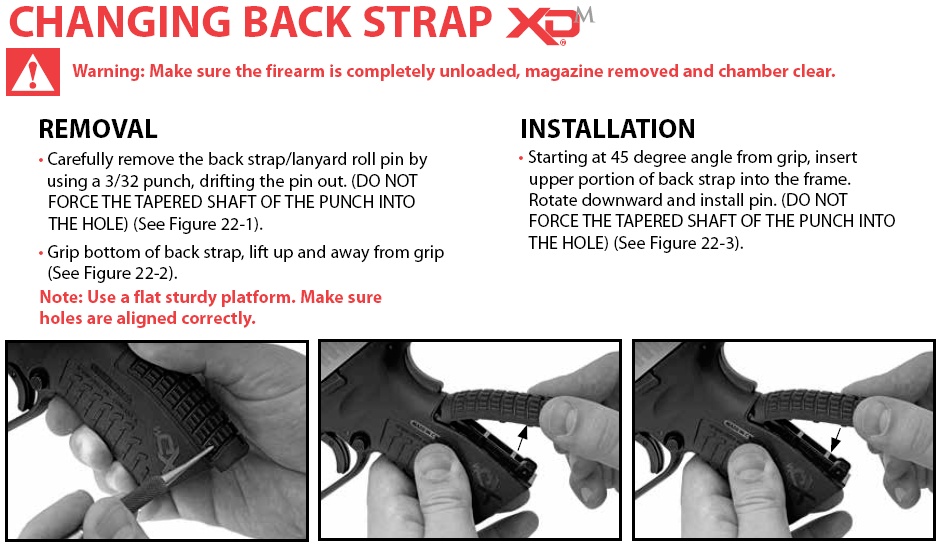 Due to the staggered magazine, the grip area of the Springfield Armory Xdm 3.8 Compact 45, the grip width is wide and measures 1.247” with a back-to-front measurement of 2.215” with the #2 (standard) grip adapter installed. Springfield provides three grip adapters for the pistol. These grip adapters are easily removed and installed on the pistol and provide a means to adapt the pistol to different hand sizes. The adaptation; however, is in the palm swell and not necessarily in the distance for the trigger finger to reach the trigger.
Due to the staggered magazine, the grip area of the Springfield Armory Xdm 3.8 Compact 45, the grip width is wide and measures 1.247” with a back-to-front measurement of 2.215” with the #2 (standard) grip adapter installed. Springfield provides three grip adapters for the pistol. These grip adapters are easily removed and installed on the pistol and provide a means to adapt the pistol to different hand sizes. The adaptation; however, is in the palm swell and not necessarily in the distance for the trigger finger to reach the trigger.
The grip width on the Ruger SR1911 CMD-A is very narrow with the grip panels provided with the pistol and is 1.34” with the standard grip panels and a front-to-back measurement of 2.158” that is more narrow than that of the Springfield Armory Xdm 3.8 Compact 45.
The grip thickness dimensions of the Ruger SR1911 CMD-A can be modified by simply changing the grip panels. There is a plethora of grip panels available for the 1911-based pistol that vary from thin (as on the Ruger SR1911 CMD-A) to “standard” to thick. I have come to prefer the rubber Hogue Monogrip with finger groves for my 1911-based pistols and have installed a set on the Ruger SR1911 CMD-A. Each side panel is comparable in thickness to a “standard” 1911 grip panel (approximately 0.25”). The grip width of the Ruger SR1911 CMD-A with the Hogue Monogrip with finger groves installed is 1.282” with a front-to back measurement of 2.056” (within the finger grooves).
When you look at it, the grip width of the Ruger SR1911 CMD-A is smaller than that of the Springfield Armory Xdm 3.8 Compact 45 and would be so regardless of the grip panels (or grip) installed. Some would say that is nice, but the Springfield Armory Xdm 3.8 Compact 45 also has two more rounds with standard magazines. That brings us to grip length.
To accommodate a 9-round staggered magazine, the grip width of the Springfield Armory Xdm 3.8 Compact 45 is naturally on the wider than that found on the Ruger SR1911 CMD-A with its 7-round, single-stack magazine. Measuring from the top of the frame (excluding the rails), the Ruger SR1911 CMD-A measures approximately 4.234”; whereas, the Springfield Armory Xdm 3.8 Compact 45 grip height measures 3.318” where measurements were taken with a magazine installed and at the approximate center of the magazine well.
The difference in grip area is more of a feeling than of a dimension. While the grip of the Springfield Armory Xdm 3.8 Compact 45 may feel just right to some folks, others will feel it needs a little more length to accommodate large hands. While some may feel that the grip length of the Ruger SR1911 CMD-A is just right, others will feel that it should be shorter to accommodate their hand. While you cannot shorten the grip length of the Ruger SR1911 CMD-A, you can lengthen the grip length of the Springfield Armory Xdm 3.8 Compact 45 by simply switching to the 13-round magazine with extension sleeve. However, and in doing so, the total grip length is increased to approximately 4.730” and this is longer than that of the Ruger SR1911CMD-A with a standard, flush-fit 7-round magazine installed. With an 8-round magazine installed in the Ruger SR1911CMD-A; however, the grip length is almost the same and not enough to discuss.
Obviously, the difference is in round count and I give that to the Springfield Armory Xdm 3.8 Compact 45, but at the expense of a larger, total grip circumference, and that translates to an increased challenge to concealability. Most people would carry a reduced capacity magazine and keep the higher capacity magazine for back-up.
Another comparison is the bore axis height, which is a relationship of the center of the bore to the hand. But, where to measure this dimension is questionable. I choose points in the center of the trigger guard against the frame and the approximate bore axis line of the barrel. The Springfield Armory Xdm 3.8 Compact 45 measured approximately 1.358” at this point. The bore axis height on the Ruger SR1911 CMD-A measured approximately 0.956” at this point. The bore axis of the Ruger SR1911 CMD-A is closer to the hand than the Springfield Armory Xdm 3.8 Compact 45. A general rule is that the closer the bore axis is to the hand, the less the muzzle rise. Both pistols have excellent “beaver tail” areas at the top of the frame. The Springfield Armory Xdm 3.8 Compact 45 has a wider “beaver tail” area and, thus, distributes recoil to the rear across a wide area of the hand while the “beaver tail” helps to keep the rear of the pistol in the web of the hand to help reduce muzzle rise.The frame of the Ruger SR1911 CMD-A is narrow and rearward recoil is more narrowly concentrated in the web of the hand. An excellent “beaver tail” in the grip of the Ruger SR1911 CMD-A does a fine job of keeping muzzle flip to a minimum.
With all this said, if you do not have a full and tight grip on either of these pistols, muzzle flip may be more than you expected. With a proper grip; however, muzzle flip is controllable on both pistols.
Allow me to say a final word or two on the grip before I close this subject. As far as grip comfort goes, and in my hand and opinion, comfort goes to the Ruger SR1911CMD-A with the rubber Hogue Monogrip with finger groves installed. Granted that I have become accustomed to finger grooves, and I wish that the Springfield Armory Xdm 3.8 Compact 45 had them. With that said, I have added a Packmyr Slip-On grip sleeve with finger groove (cannibalized from my Glock G30) to the Springfield Armory Xdm 3.8 Compact 45. This little addition has made a world of difference to the feel of the grip. The slip-on grip does not interfere with the grip safety, the finger groove is just about perfect for my hand, and the gripping surface is far more positive.
While the 13-round extended magazine w/extension sleeve feels good in the hand, the texturing of the grip could be a little less. And, while I said that I would not mention a Glock pistol, the grip of the Glock G30 feels real good as compared to the Springfield Armory Xdm 3.8 Compact 45. In my mind (and opinion, of course), had Springfield backed off a little on the texturing, incorporated finger grooves in the grip, and lost one round in the extended magazine (making it a 12-round), I would regard the Springfield Armory Xdm 3.8 Compact 45 a high contender for concealed carry. Now, I know that you are saying that there is a Talon grip pattern for the Springfield Armory Xdm 3.8 Compact 45. I am not a fan of taping my guns and the Packmyr grip sleeve that I installed will work just fine. And, perhaps there will be available a pinky hanger magazine extension in the near future for the 9-round magazine, but a pinky-hanging magazine extender is not available at the time of this review. The grip is but one consideration that I (and maybe you) have to think about before considering a pistol or revolver ready for carry. I simply like all of my digits around a grip even though I only use two of them for a tight grip.
SAFETIES:
 We cannot downplay the safety aspects of any firearm. It does seem; however, that some pistol manufacturers have for the sake of ease of operating their particular pistol. Some manufactures have seen the litigious light and opted to meet safety somewhere in the middle for their sake. We have come a long way from old single-action revolvers that were only safe when carrying 5 of 6 rounds and the hammer needed to be resting on an empty chamber in the cylinder.
We cannot downplay the safety aspects of any firearm. It does seem; however, that some pistol manufacturers have for the sake of ease of operating their particular pistol. Some manufactures have seen the litigious light and opted to meet safety somewhere in the middle for their sake. We have come a long way from old single-action revolvers that were only safe when carrying 5 of 6 rounds and the hammer needed to be resting on an empty chamber in the cylinder.
The Glock “Safe Action” pistol incorporates all passive safety devices; devices that do not require any thought by the pistol’s operator. Springfield also incorporates passive safeties, but added one extra layer of safety over the Glock pistols – the grip safety.
The Ruger SR1911CMD-A, being modeled in the old school 1911 fashion has both active and passive safeties in the form of the thumb safety and grip safety, accordingly. Since I am reviewing the Springfield Armory Xdm 3.8 Compact 45 and Ruger SR1911CMD-A, I will keep the discussion between these two pistols and will try not refer to the Glock pistols further.
The Springfield Armory Xdm 3.8 Compact 45, incorporates a drop safety. The Ruger SR1911CMD-A also incorporates a drop safety, but in a different and just-as-effective way. The firing pin of the Ruger SR1911CMD-A is made of Titanium and the firing pin spring is very heavy. The combination of the two prevents the pistol from firing should it be dropped directly on the hammer.
The Springfield Armory Xdm 3.8 Compact 45, like the Ruger SR1911CMD-A has a grip safety. There is a difference in the two designs, however.
The grip safety of the Springfield Armory Xdm 3.8 Compact 45 also prevents the slide from moving to the rear unless the grip safety is pressed. The grip safety on the Ruger SR1911CMD-A has no effect on slide operation – the thumb safety does that. The slide cannot be retracted when the thumb safety of the Ruger SR1911CMD-A is up (on safe).
There are manufacturers that have beat the safety bush and tried to meet things safety halfway. Both Ruger (SR series of striker fired pistols) and Smith & Wesson, for example, have incorporated thumb safeties (active safeties) in their striker-fired pistols without the complexity of a passive grip safety. The issue is that most people won’t use the thumb safety. Perhaps, it is because the safety lever is too small or cannot be easily manipulated with the thumb, or whatever. And, I grant you that having a thumb safety does add to the complexity of the pistol’s operation, but it is a complicity that can be resolved through training.
Personally, I have no issues with a grip safety on any pistol unless it doesn’t work properly. I also have no issues with a pistol equipped with a thumb safety, unless the safety lever is too small or cannot be easily manipulated with the thumb. The thumb safety lever on the Ruger SR1911CMD-A is substantial and easily manipulated. I do have issues on pistols that do not incorporate one or both type of safeties. It has never made sense to me to place a stop switch in the middle of a go switch without some other means of insuring my safety as well as the safety of others. And, yes there are pistols that are Double-action Only (DAO) and have the characteristics of a long and heavy double-action revolver’s trigger. But, the two pistols under review are not one of these so I need not to go further in digressing about these.
The grip safety on the Springfield Armory Xdm 3.8 Compact 45 is a very simply affair; a simple rotating lever that is built high into the back strap of the pistols and is easily pressed when the pistol is properly gripped. The grip safety on the Ruger SR1911CMD-A also incorporates a highly-regarded and very effective beavertail that allows you to get your hand as high on the grip as possible without worrying about getting bit by the hammer or slide. Like the grip safety on the Springfield Armory Xdm 3.8 Compact 45, the grip safety on the Ruger SR1911CMD-A is easily pressed by the gripping hand.
Note that neither of these pistols incorporate a magazine disconnect safety.
EASE OF DISSASSEMBLY and ASSEMBLY:
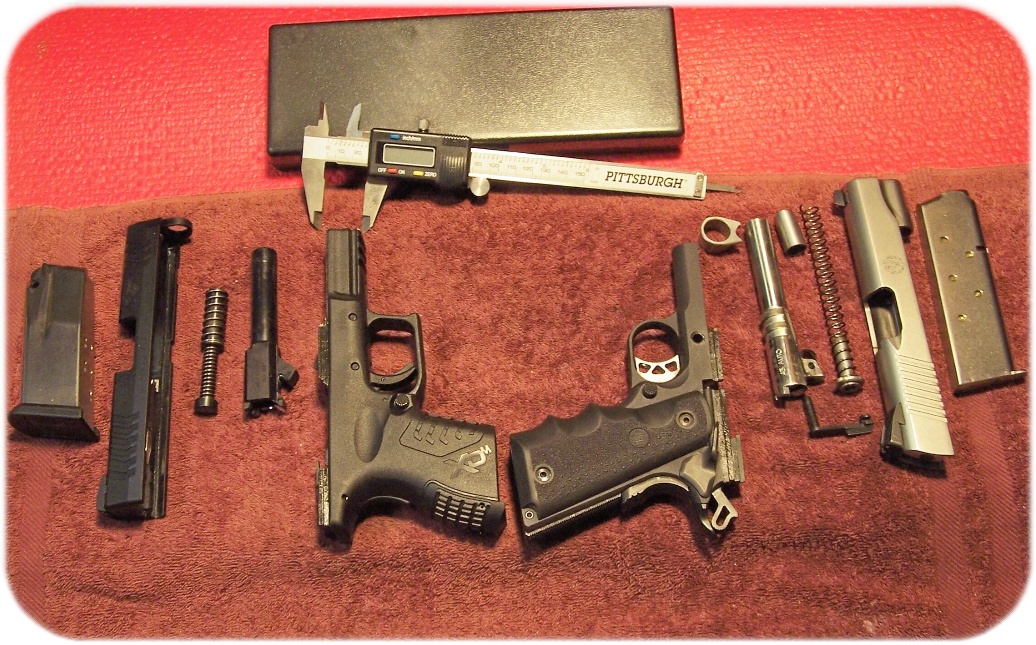 As far as disassembly and assembly of the Springfield Armory Xdm 3.8 Compact 45 and the Ruger SR1911CMD-A, the point goes to the Springfield Armory Xdm 3.8 Compact 45.
As far as disassembly and assembly of the Springfield Armory Xdm 3.8 Compact 45 and the Ruger SR1911CMD-A, the point goes to the Springfield Armory Xdm 3.8 Compact 45.
Springfield Armory Xdm 3.8 Compact 45 Disassembly:
- Ensure that the pistol is unloaded and safe.
- Retract the slide and lock it into place with the Slide Stop Lever.
- Rotate the Disassembly lever to the vertical position.
- Pull back the slide slightly, and then slide it off from the frame – and you don’t have to pull the trigger, or push down the ejector (Ruger SR series of SF pistols) to remove the slide.
To further the disassembly, remove the Recoil Guide Assembly toward the rear of the slide. Then, remove the barrel toward the rear of the slide.
Ruger SR1911CMD-A Disassembly:
While disassembly of the Ruger SR1911CMD-A is not complex, it does take a few steps to dissemble it.
- Ensure that the pistol is unloaded and safe.
- Cock the hammer and place the thumb safety lever to the “Safe” position to lock the slide.
- From the muzzle end, press the Guide Rod Spring Plug inward.
- While keeping the Guide Rod Spring Plug pressed inward, rotate the barrel bushing clockwise until it is clear of the Guide Rod Spring Plug.
- Slowly release tension on the Guide Rod Spring Plug and set it aside.
- Place the thumb safety lever down to the “Off safe” position.
- Retract the slide until the disassembly notch aligns with the head of the Disassembly lever.
- Push the Disassembly unit from the frame of the pistol.
- Remove the slide from the frame.
- Remove the Guide Rod and Guide Rod Spring toward the rear of the slide.
- Remove the Barrel Bushing by turning it counter-clockwise until it stops and then pull outward.
- Remove the barrel through the front of the slide.
Springfield Armory Xdm 3.8 Compact 45 Assembly:
- Place the barrel into the slide from rear to front of the slide.
- Set the Recoil Guide assembly into place.
- Install the slide to the frame and lock into place with the Slide Stop Lever.
- Rotate the Disassembly lever to the horizontal position.
- Pull the slide slightly rearward and then slowly release the slide to allow it to go into battery.
- Perform a function test.
Ruger SR1911CMD-A Disassembly:
While assembly of the Ruger SR1911CMD-A is not complex, it does take a few steps to assemble it.
- Insert the barrel into the slide from the muzzle end.
- Install the Barrel bushing and then turn it fully clockwise (as viewed from the muzzle).
- Install the Guide Rod and Guide Rod Spring (ensure that the Guide Rod is properly seated against the barrel).
- Position the Swing Link to accept the pin of the Slide Stop.
- Install the slide into the frame.
- Insert the Slide Stop pin just enough to catch the Swing Link.
- Position the slide so that the Takedown Notch and the head of the Slide Stop assembly align.
- Press the Slide Stop Assembly completely into the frame.
- Move the slide forward until it stops.
- Place the thumb safety lever into the “safe” position to lock the slide.
- From the muzzle end, install the Recoil Spring Plug onto the Recoil Spring.
- Slowly press the Recoil Spring Plug into the slide enough to clear the Barrel Bushing.
- While maintaining pressure on the Recoil Spring Plug, rotate the Barrel Bushing counter-clockwise until the Groove in the front of the barrel Bushing captures the Recoil Spring plug.
- Release tension on the Recoil Spring Plug.
- Place the Thumb Safety Lever to the “Off Safe” position (down).
- Cycle the slide and perform a function test.
Both pistols can be, with practice, disassembled and assembled very easily – even while the operator is blindfolded – unless Gunnery Sargent R.Lee Ermy comes in a takes away a part or two.
RANGE WORK:
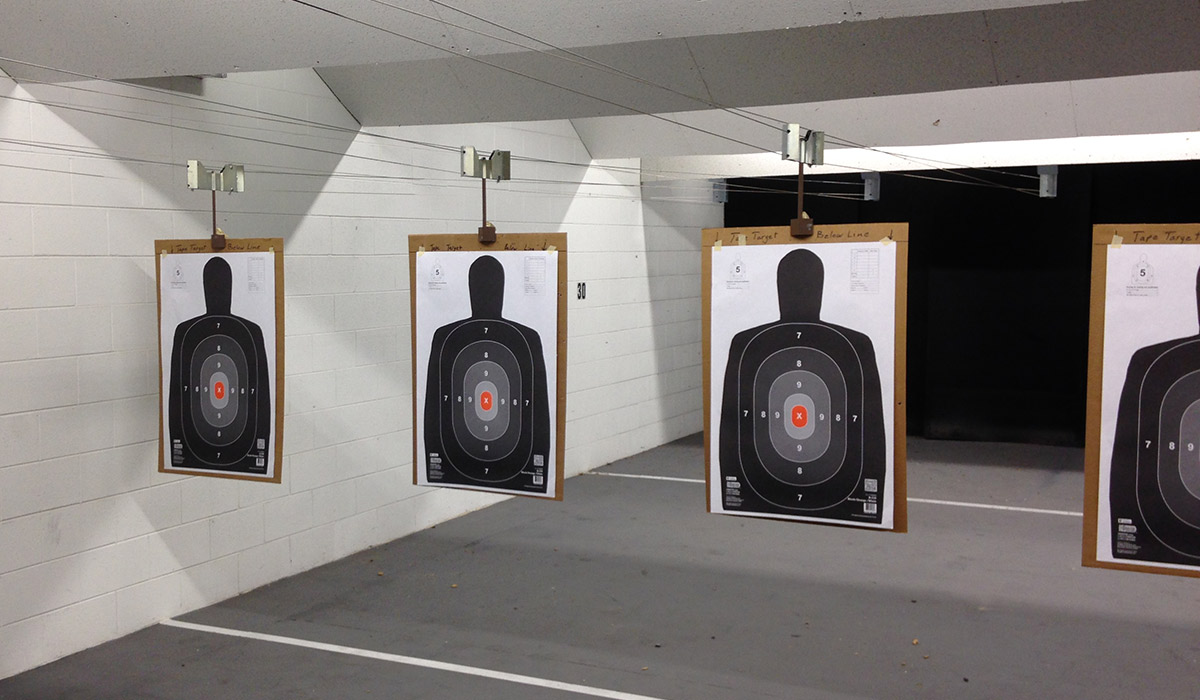 Wow! I have covered a lot of ground getting to this point.
Wow! I have covered a lot of ground getting to this point.
I am not going to go into accuracy of the pistols under review except to say that as long as you do your part both of the pistols will do their part. Why do I say that? I say that because I can be accurate with one pistol one day and am more or less accurate with it the next day (according to my standards of accuracy). There are just some days when my MOA goes MIA.
Both pistols have shown that that are extremely reliable with any ammunition fed through them.
Muzzle flip is controllable with both, but a little more controllable with the Ruger SR1911CMD-A; the bore axis is closer to my hand with the Ruger and I am able to get higher on the back strap with the Ruger SR1911CMD-A than I can with the Springfield Armory Xdm 3.8 Compact 45. Some folks; however, may have the exact opposite experience. I do; however, feel more in control with the Ruger SR1911CMD-A, but I may contribute that to the grip setup (rubber, finger-groove grip).
It does take some getting used to two entirely different triggers being pulled on the same day, but after a full magazine of ammunition was fired it was not hard to become accustomed to either trigger.
The overall feel of both pistols is that they are balanced when loaded. Unloaded, the Springfield Armory Xdm 3.8 Compact 45 feels slightly slide heavy and that feeling goes away somewhat when a full magazine was inserted; whereas, the Ruger SR1911CMD-A felt balanced when loaded or unloaded.
While the Ruger SR1911CMD-A was hitting a POA, I was hitting low with the Springfield Armory Xdm 3.8 Compact 45 using the same ammunition and at the same distance. Just for giggles and chuckles, I changed out the grip adapter on the Springfield Armory Xdm 3.8 Compact 45 from the #2 (comes standard on the pistol) to the #1 (least arched). Although still slightly arched, the grip of the pistol feels a lot better with the #1 adapter, which is surprising. However, the #1 grip adapter makes the grip feel more like that of the 1911 since the arch is reduced. Whether it was psychological or whatever, my shots with the pistol definitely came up and my groups improved. A simple swap of the magazine extension to the #1 unit mated the grip and magazine perfectly.
I asked two of my shooting friends to shoot both pistols that were loaded with the same ammunition and then give me an honest opinion of both pistols. One shooter carries a 1911 and the other a Glock G19. The 1911 carrier used the extended magazine with the Springfield; whereas, the Glock shooter used the standard 9-round magazine, as he is used to carrying the G19 with a standard magazine. Both liked the trigger of the Ruger SR1911CMD-A. The 1911 carrier said that he thought that there was more muzzle flip with the Ruger SR1911CMD-A. I was able to place eight, moderately fired head shots in a 2” group. I could not match that with the Springfield Armory Xdm 3.8 Compact 45, but I don’t feel that it has anything to do with the pistol and has everything to do with the operator and lack of trigger time with this pistol, which I hope to rectify.
CARRY CHARACTERISTICS:
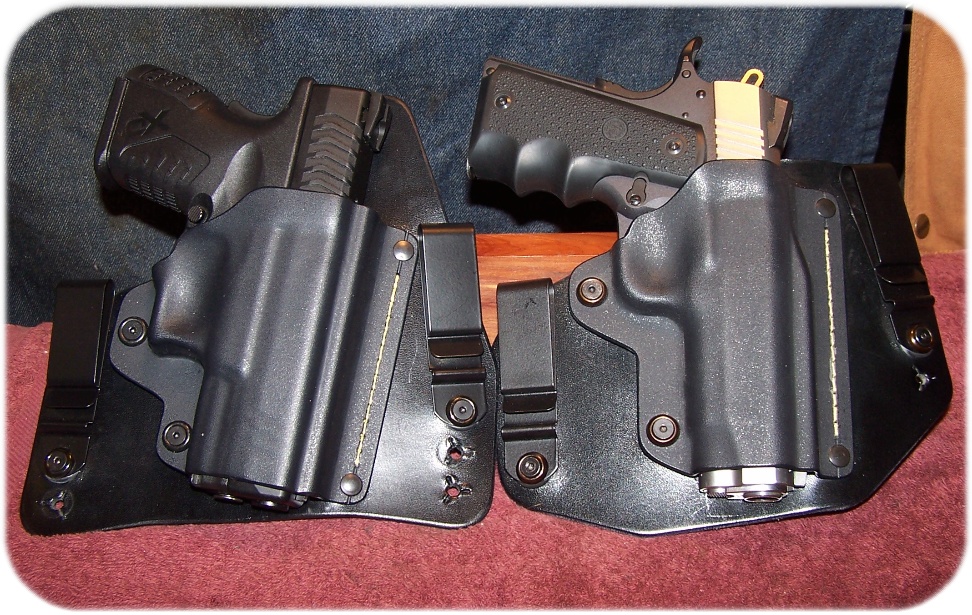 When we try to select a pistol for concealed carry, there is always a question concerning how well it will conceal. We may know how accurate and reliable a pistol may be but not only do we have to consider carrying the pistol but also one or two spare magazines – it’s all part of the carry equation.
When we try to select a pistol for concealed carry, there is always a question concerning how well it will conceal. We may know how accurate and reliable a pistol may be but not only do we have to consider carrying the pistol but also one or two spare magazines – it’s all part of the carry equation.
Finding a good holster for IWB is not a hard thing these days. I have found that Black Arch Holsters are excellent and is what I use for the Springfield Armory Xdm 3.8 Compact 45 and the Ruger SR1911CMD-A. While I have removed the sweat guard on the holster for any 1911-based pistol, the holster for the Springfield Armory Xdm 3.8 Compact 45 has the sweat shield intact.
Both holsters have been adjusted for my preferred holster cant and ride height for each pistol. I prefer my IWB holsters to be as low as possible and had to select a different hole in the holster to give me the lower ride height that I wanted.The holster for the Ruger SR1911CMD-A is narrower than the holster for the Springfield Armory Xdm 3.8 Compact 45 but the holster for the Springfield Armory Xdm 3.8 Compact 45 is no wider than the holster (CBST) for the Bersa Thunder Compact Pro 45 that I used to carry. The bottom line is if you can conceal a Glock pistol, you will be able to conceal both of the pistols being reviewed.
As with the pistols, I carry spare magazines IWB and this is where I have to award a point to the Ruger SR1911CMD-A and its single-stack magazine. It is far more comfortable to carry two-spare 8-round single stack magazines than one 13-round staggered magazine let alone two. I carry the two 1911 magazines in a modified Remora magazine pouch just before my right hip. I can adamantly state that carrying two (or even one) magazine for the Springfield Armory Xdm 3.8 Compact 45 is not pleasurable and I may be forced to carry one magazine in a horizontal OWB magazine pouch.
Coming out of the holster there is a definite difference in feel of the two pistols.
With the Springfield Armory Xdm 3.8 Compact 45, I feel a little short-changed in the grip department. When I pull the Springfield Armory Xdm 3.8 Compact 45 from the holster, I place my thumb over the rear sight and use as much of the hand as possible around the grip. While I can grip the pistol with three fingers it does take a conscious effort to do so. I feel that the pistol could use a magazine extension, like the Pierce, that would allow my little finger something to hook onto. As the pistol moves into a horizontal position and is going on target, and the support hand comes into position, my thumb slides down the side of the slide as if I were wiping a thumb safety to the “Fire” position. It is just a natural thing for me to do because of my years with 1911-based pistols. With the 13-round magazine installed, there is no issue with not having enough gripping surface, but I would not carry the pistol with this magazine installed – I might as well carry a full-size XDm. I do find that the grip length of the Springfield Armory Xdm 3.8 Compact 45 with the standard 9-round magazine installed does aid in the concealment department over the longer grip on the Ruger SR1911CMD-A.
After carrying the Springfield Armory Xdm 3.8 Compact 45 in a Black Arch holster for the week, I did have to adjust the holster for cant and carry depth. This involved moving the rear mounting screw one hole up, which reduced the cant to a 15-degree angle and lowered the rear of the holster more into the trousers. The Springfield Armory Xdm 3.8 Compact 45 now carries as comfortable as the Ruger SR1911CMD-A even with the 13-round magazine installed. I am starting to get used to the Springfield Armory Xdm 3.8 Compact 45 and really starting to like it – I do not just fully like it yet.
The long grip length of the Ruger SR1911CMD-A affords a lot more real estate for a hand purchase. My fingers fall into the finger grooves quite well. My thumb is held high and remains high until I come on target. I will say that the thumb safety on the Ruger SR1911CMD-A is very easy to wipe into the “Fire” position. In fact, it might be too easy and I am going to increase the plunger spring tension a bit to increase the drag on the thumb safety lever; an operation that is, thankfully, easy to do on a 1911. The longer grip length of the Ruger SR1911CMD-A does pose a challenge for concealment. However, the holster that I use has been adjusted for a cant and a ride depth that maximizes concealment. The Ruger SR1911CMD-A is very concealable, but care should be taken when bending over at the waist to prevent the butt of the pistol from printing – especially in the hot summer months and light outer clothing is worn.
CONCLUSION:
 One of the questions that I ask myself when owning a particular firearm is would I consider buying this firearm again. In some cases, the answer is no. In some cases, the answer is maybe. For others, the answer is a definite yes. In the case of the Springfield Armory Xdm 3.8 Compact 45, the answer is yes, and the answer is the same for the Ruger SR1911CMD-A.
One of the questions that I ask myself when owning a particular firearm is would I consider buying this firearm again. In some cases, the answer is no. In some cases, the answer is maybe. For others, the answer is a definite yes. In the case of the Springfield Armory Xdm 3.8 Compact 45, the answer is yes, and the answer is the same for the Ruger SR1911CMD-A.
The Springfield Armory Xdm 3.8 Compact 45 was the less expensive of the two, but not by a wide margin considering the date upon which both were purchased. With that said, and at today’s prices, the MSRP difference between the two pistols has increased. The MSRP of the Ruger SR1911CMD-A is now $979 (according to Ruger); whereas, the MSRP of the Springfield Armory Xdm 3.8 Compact 45 is $659. Obviously, these pistols can be found for less and you need to do your research and brush up on your bargaining skills with you LGS. I purchased my SR1911CMD-A in 2015 for $741 (including tax) at a LGS.
With a little research at Davidson’s Gun Genie I found that the Ruger SR1911CMD-A is now going at an average of $736 in my area. The Springfield Armory Xdm 3.8 Compact 45 is in the $550 range. Both estimates include transfer fees and taxes, of course. For comparison purposes, a Glock G30SF GEN4 is selling for $545 through Bud’s Gun Shop (the G30SF is not currently available through Davidson’s) and a Springfield Range Officer Compact 1911 is selling between $786 to a hair over $800 through Davidson’s for my area.
What it comes down to is the cost per benefit ratio of owning a Springfield Armory Xdm 3.8 Compact 45 or a Ruger SR1911CMD-A. Both are excellent pistols in their platform and class. With the Springfield Armory Xdm 3.8 Compact 45, you get an excellent carry pistol that can hold 9+1 with a standard magazine and 13+1 with the extended magazine and has an extra measure of safety built in, with the grip safety, over the Glock G30SF. With the Ruger SR1911CMD-A, you get a time and battle proven platform that has been brought up to excellent manufacturing and material standards, and comes with features found in many higher-priced 1911-based pistols. Either of these pistols will serve you well. Both pistols are accurate and reliable. I will give a point to the Ruger SR1911CMD-A simply because there is a plethora of product available to support and/or customize this pistol as compared to the Springfield Armory Xdm 3.8 Compact 45. Aside from changing sights on the Springfield Armory Xdm 3.8 Compact 45, there is not a lot that can be done to this pistol to make it truly yours. But, to tell the truth, aside from my personal preferences, there is not a lot that I would change on the pistol, but I would not mind if Springfield caved into my preferences.
I have covered a lot of area, which is normal when trying to compare two pistols and especially when trying to compare two pistols of different platforms. The Ruger SR1911CMD-A is the more flexible of the two pistols in regards to accessories and custom parts, but the Springfield Armory Xdm 3.8 Compact 45 is what it is – a solid contender for concealed carry and even competition.
Another point to the Ruger SR1911CMD-A is that it functions well with any magazine intended for the 1911 (excluding staggered magazine for large capacity 1911 like the Para 14-45). With the Springfield Armory Xdm 3.8 Compact 45, you are restricted to Springfield magazines (from what I can tell) and have a choice between 9-round, 10-round, and 13-round (depending on state restrictions).
As a last word, I have been carrying the Springfield Armory Xdm 3.8 Compact 45 for several weeks now with the standard capacity, 9-round magazine but with only 8-rounds installed and one chambered. I carry the Ruger SR1911CMD-A with the same number of rounds. I wanted to be as fair as possible when pitting these two pistols against each other. I shoot each equally well, but one just feels better in my hand. If you are considering either of these pistols, or two different pistols within the two platforms I presented, it is ultimately your decision as to which is the best in your hand.
REFERENCES and JUST DON’T TAKE MY WORD FOR IT:
I include in this section; references, linked articles, and linked videos for both the Springfield Armory 3.8 Compact 45 and the Ruger SR1911 CMD-A. While I have my viewpoints regarding each pistol, it is sometimes advantageous to include other viewpoints as well.
Springfield Armory Xdm 3.8 Compact 45:
- XD(M)® 3.8″ Compact .45ACP: http://www.springfield-armory.com/products/xdm-compact-45-acp/
- Black Arch Holsters: https://www.blackarchholsters.com/products/ace-1-gen-2-holster
- XDm 45 Compact: https://www.youtube.com/watch?v=tR9LOuL8aYI
- XDm 45 Compact VS Glock 30: https://www.youtube.com/watch?v=61mgZT5gNBI
- Glock 30 or XDm Springfield Compact .45? weaponseducation: https://www.youtube.com/watch?v=GXHRlQ3vcQk
- Springfield XDM 3.8 Compact in .45: https://www.youtube.com/watch?v=WfDd_2i6EGY
- Gun review – Springfield XDM 3.8 Compact .45 ACP: http://www.personaldefenseworld.com/2013/02/springfield-xdm-3-8-compact-45-acp/#_dsc6341_phatchfinal
- XDM 45c shooting review: https://www.youtube.com/watch?v=MSUcJeCKzW4
- Springfield XDm Compact .45, 13 Plus 1… Glock Killer? weaponseduction: https://www.youtube.com/watch?v=XZ3JhJ1rB7o
- DPM Worlds Only Progressive Triple Spring Recoil Reduction System: https://www.youtube.com/watch?v=8_RlMOBMWF4
Ruger SR1911 CMD-A:
- http://ruger.com/products/sr1911/specSheets/6711.html
- Shooting the NEW Ruger Lightweight SR1911CMD-A 45 ACP Semi-Automatic Pistol- Gunblast.com: https://www.youtube.com/watch?v=5KzEynK7wvI
- SR1911 Lightweight Commander: https://www.youtube.com/watch?v=_o3BNVyJKMs
- Hogue Rubber Grip Govt. Model Rubber Grip with Finger Grooves: http://www.amazon.com/Hogue-Rubber-Govt-Finger-Grooves/dp/B001QVYT72/ref=sr_1_1?ie=UTF8&qid=1440507901&sr=8-1&keywords=Hogue+1911+grips
- Black Arch Holsters: https://www.blackarchholsters.com/products/ace-1-gen-2-holster
![]()


